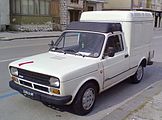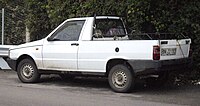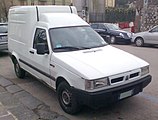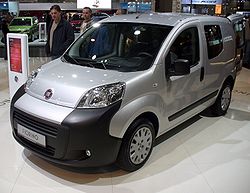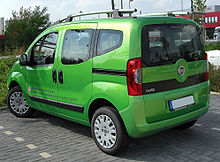Fiat Fiorino
| Fiat Fiorino | |
|---|---|
| Production period: | since 1977 |
| Class : | Utilities |
| Body versions : |
Panel van, platform truck, high roof combination |
| Previous model: | Fiat 900 |
| Successor: |
Fiat Strada (Pick-up) Fiat Doblò (Panel Van) Fiat Fiorino Furgao ( Panel Van ) |
The Fiat Fiorino is a since 1977 in Brazil built vans of the Italian car manufacturer Fiat . In the first two generations it was produced as a panel van and flatbed truck. The third generation has been manufactured as a small van / high-roof station wagon at the automobile manufacturer Tofaş in Bursa (Turkey) since 2008 and was voted Van of the Year in 2009. The Peugeot Bipper and the Citroën Nemo by PSA Peugeot Citroën were also produced there as identical models until the end of 2014 . In Brazil, another Fiorino model has been manufactured as a panel van with the Fiat Fiorino Furgao since 2013 .
Type 127/147 (1977-1987)
The first generation of the Fiorino, which was built from October 1977 to December 1987, was based on the Fiat 147, the Brazilian version of the Fiat 127 , with a box on the rear. The Fiorino was manufactured in the Brazilian plant in Betim . It had a 0.9 liter engine that developed 45 hp (33 kW) and could accelerate the car to 125 km / h. The payload was approx. 360 kg.
In January 1980 there were some modifications. The engine got one liter and 50 HP (37 kW), the bumpers were now made of plastic.
After another facelift carried out in parallel to the 127 in spring 1982, a 45 hp (33 kW) diesel variant was added.
The Karosseriewerke Weinberg also offered a camping version of the Fiorino.
Type 146 (1988-2013)
The second generation was created on the platform of the Brazilian Fiat Uno , but there were three sub-series that were technically very different from each other:
The front section of the version produced from the beginning of 1988 to spring 1992 was taken over from the Uno up to the B-pillar, as was the interior. The technology, however, had hardly changed since the first Fiorino. The basis was the Brazilian UN with the rear axle of the Fiat 127, recognizable by the higher bonnet with the spare wheel underneath. As before, entire assemblies such as the chassis and drive parts were taken over directly from the predecessor. The strut domes, the struts, the front axle and the rear axle consisting of a transverse two-leaf spring , trapezoidal wishbones and shock absorber struts corresponded to those of model 147.
The old technology was still used for the second series, which was built from spring 1992 to the end of 1993. There was a facelift on the body that was stylistically based on the Uno II. Headlights, fenders, bonnet and grill were only found on the Fiorino in Europe and are not identical to the European UN. These parts came from the Uno CS, which was only built in this form in Brazil. The interior retained the appearance of the Uno I.
The third series (beginning 1994 to 2013) broke with both the technology of the Type 147 and the appearance of the Uno I. The wheelbase and the vehicle length grew somewhat, the chassis and the axle geometry were now designed like the Uno and the The rear axle was now rigid and suspended from two lengthwise leaf spring packages, which contributed to improving driving behavior. The external shape remained almost unchanged compared to the second sub-series; these younger models can often be recognized by the raised roof and the slightly different box structure. The glazed or corrugated parts of the side wall were only designed with two surfaces per side instead of four. Late models of the third sub-series got a different grille with only one cross spoke. In the interior, the Uno II equipment also found its way into the third sub-series.
A closed box, glazed box superstructure and a pickup were available as body variants. The latter is relatively rare and sought after. Mobile homes based on the Fiorino were also offered.
In addition to a 1.7-liter diesel, the range of engines included various gasoline engines with capacities ranging from 1.1 to 1.6 liters. Since the Fiorino was first and foremost a craftsman's vehicle, the diesel engine was preferred, which was offered in a 46 kW (63 hp) turbo version in the last models.
In December 2000 the sale of the Fiorino series in Europe was stopped. The Fiat Strada (based on Punto or Palio) and the Fiat Doblò were introduced here as successors .
In Brazil, the Fiorino was produced with modifications for South America until 2013 and then replaced by the Fiat Fiorino Furgao based on the Fiat Novo Uno .
Type 225 (since 2008)
| 3rd generation | |
|---|---|
|
Fiat Fiorino station wagon (2008-2016) |
|
| Production period: | since 2008 |
| Body versions : | High roof combination |
| Engines: |
Otto engine : 1.4 liters (51–57 kW) Diesel engine : 1.3 liters (55–70 kW) |
| Length: | 3957-3971 mm |
| Width: | 1716 mm |
| Height: | 1721 mm |
| Wheelbase : | 2513 mm |
| Empty weight : | 1145-1165 kg |
Since February 2008, Fiat has been offering the high-roof estate made by Tofaş as the Fiorino , which was also available as the Peugeot Bipper and Citroën Nemo until 2016 .
The Fiorino, which is classified below the Fiat Doblò , is the smallest Fiat commercial vehicle and is available in three variants: as a panel van (no side windows from the B-pillar), station wagon (one side window behind the B-pillar) and as a car (two side windows behind the B-pillar). The car version is called Fiat Qubo . In Chile , this generation is available as the Ram V700 City in the model range, the Fiat model is not represented there.
The panel van and the station wagon are available in the basic and SX versions. The car (Fiat Qubo) available since October 2008 is available in the equipment variants Active, Dynamic and Trekking.
All panel van and station wagon variants can be ordered in the off-road "Adventure" look for an additional charge. Standard in all versions: ABS with electronic brake force distribution (EBD), driver airbag, power steering, automatic headlight range control, side strips, integrated hubcaps, radio preparation (wiring, loudspeakers, antenna) and carpeted cargo area. In addition, the SX version offers electrically adjustable and heated exterior mirrors, a second sliding door on the side, a separately lockable load compartment, remote-controlled central locking and automatic door locking while driving (from 5 km / h), storage compartment in the door, electric windows, driver's seat with armrests, height-adjustable seat with Lumbar support, high quality upholstery, height-adjustable steering wheel, outside temperature sensor and removable interior lighting.
The special equipment and accessories include: passenger airbag and side airbags, parking sensors, car radio with MP3 player, Bluetooth® system with voice control, seat heating for the driver's seat, roof rails, rotating protective grille and many other options.
At the end of 2009, a natural gas (CNG) version of the Qubo was released with the 1.4 liter engine and 13 kg natural gas tank already familiar from the Fiat Panda Classic and Punto Evo .
Facelift 2016
In April 2016, Fiat Professional carried out a facelift for the Fiorino series; this particularly affected the completely redesigned front bumper . Inside, a new steering wheel was installed as well as an infotainment system with a 5-inch touchscreen, which integrates the car radio, satellite navigation, Bluetooth, USB and AUX. The entire range of engines was approved for Euro 6 .
Engines
1.4 8V (Otto engine):
- Cubic capacity 1368 cm³
- 57 kW (77 hp) at 5200 min -1
- 118 Nm at 2600 min -1
- Top speed 155 km / h
- Acceleration 0-100 14.7 s
1.4 8V Natural Power (Otto engine with additional natural gas supply):
- Cubic capacity 1368 cm³
- 51 kW (70 hp) at 6000 min -1 (natural gas), 57 kW at 6000 min -1 (gasoline)
- 104 Nm at 3000 min −1 (natural gas), 115 Nm at 3000 min −1 (gasoline)
- Top speed 149 km / h (natural gas), 155–157 km / h (petrol)
- Acceleration 0-100 17.5 s
1.3 Multijet 16V (diesel engine):
- Cubic capacity 1248 cm³
- 59 kW (80 hp) at 3700 min -1
- 190 Nm at 1750 min -1
- Top speed 161 km / h
- Acceleration 0-100 13.9 s
1.3 Multijet 16V (diesel engine):
- Cubic capacity 1248 cm³
- 70 kW (95 hp) at 3750 min -1
- 200 Nm at 1750 min -1
- Top speed 167 km / h
- Acceleration 0-100 11.9 s
Hold
The cargo area is 1.52 m long (2.49 m with the passenger seat folded down) and 1.47 m wide. The distance between the wheel arches is 1.04 m. The loading space is 1.18 m high and has a loading volume of 2.5 m³. When the front passenger seat is folded down, this can be increased to a maximum of 2.8 m³. The rear door of the Fiat Fiorino has two asymmetrical (40/60 ratio) sheet metal door leaves that can be opened up to 90 ° or 180 °, making loading and unloading easier. The rear opening has a width of up to 1.14 m and a height of up to 1.06 m. In addition, the Fiat Fiorino has a 527 mm high loading sill.
safety
The standard equipment includes: ABS with electronic brake force distribution (EBD), hydraulic power steering, front disc brakes, 3-point seat belt with belt tensioner and force limiter, driver airbag and the dead-lock system: an anti-theft protection system that locks all doors so that they are neither from inside can still be opened from the outside. Passenger airbag, side airbags and parking sensors round off the safety package of the Fiat Fiorino.
The separate locking of the front and rear doors offers increased safety during loading and unloading. This allows the driver's cab to be locked if only the cargo space is to be accessible.
Unlike Peugeot Bipper and Citroën Nemo, the Qubo in the “Trekking” equipment variant is equipped as standard with Electronic Stability Control with brake assist , traction control , engine drag torque control and hill start assist .
Registration numbers
Between January 2008 and December 2019, a total of 12,880 Fiat Fiorinos were newly registered as passenger cars in the Federal Republic of Germany. 2009 was the most successful sales year with 2,899 units.
Type 327
A new model based on the Fiat Type 327 has been available in Brazil since 2013 .
